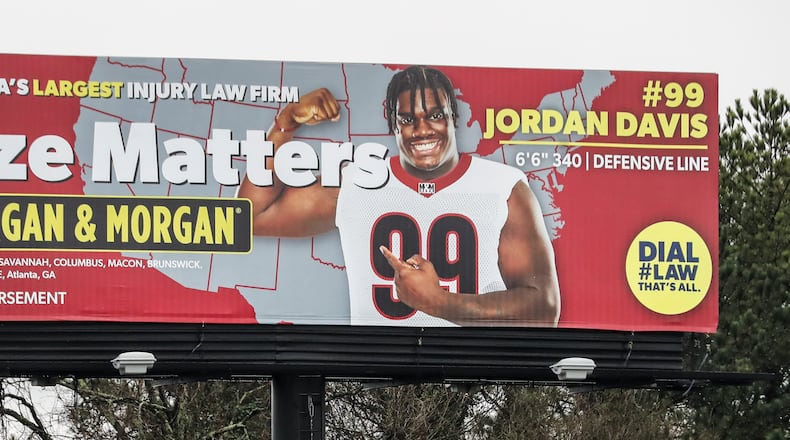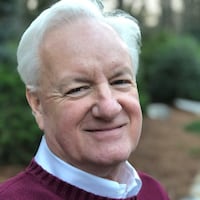Aaron Murray saw first-hand how dramatically life has changed for college athletes.
“We had a little dinner in Athens, and oh my God, I’m handing these 19-to 22-year-olds checks for $28,000,” said Murray, the former Georgia Bulldogs quarterback who remains the SEC career leader in passing yards. “I was lucky to have a few hundred bucks in my bank account (during college).”
Eleven members of Georgia’s 2021 national championship football team reacted with “big eyes,” Murray said, when they received the checks last month — their shares from the early profits of a new venture launched by Murray and several other former UGA players turned marketing entrepreneurs.
For generations, college athletes were forbidden by NCAA rules from receiving compensation for endorsements, autographs and the like, or from using their “name, image and likeness” (NIL) in any way to earn profits. Those caught breaking the draconian rules drew suspensions for multiple games, as happened to Murray’s former teammates A.J. Green and Todd Gurley. But that all changed last summer when new state laws took effect around the nation, enabling college sports stars to make money from their NIL rights and forcing the NCAA to back down from its historical intransigence on the subject.
“It’s really opened the door for athletes, who never should have been prevented from exploiting their fame,” said Fort Lauderdale-based attorney Darren Heitner, whose practice includes sports law. “Overall, I’m quite pleased with how this has been playing out.”
Credit: ArLuther Lee
Credit: ArLuther Lee
What’s playing out is fundamentally fairer to the athletes than the old system, yet rife with complications as rules and interpretations vary from state to state and school to school.
“That’s why it’s the ‘Wild Wild West,’” Murray said. “Because it’s not uniform across the country. … Certain states are allowing more involvement for the universities.”
States began passing laws in 2019, California going first, in response to widespread criticism of the NCAA’s stance on athletes’ financial rights. Twenty-seven states had acted by July 1, 2021, the earliest effective date of the various laws, whereupon the NCAA lifted its ban on NIL activity for athletes in all states.
The infancy of college sports’ NIL era has brought upheaval in unforeseen and hectic ways.
“I think the thing that’s been surprising is the lack of national regulation,” said Chase Garrett, founder and CEO of Denver-based Icon Source, a marketplace that connects brands with athletes. “Without that (regulation), you’re going to see a lot of really ambitious groups want to maximize what’s available and what’s legal. Right now, there are a lot of things that are not breaking the rules that can give certain groups an advantage.
“I don’t know if, long term, people funneling money to athletes is a sustainable model. But in the short term, if it is done the right way, you can’t really blame the organizations that are really passionate about their (teams).”
When the transformative change occurred last summer, the immediate flurry of deals consisted mostly of businesses paying athletes for advertisements, appearances, social-media posts, etc. All of that continues, but the space also has grown far more complex, including the emergence of school-specific collectives that pool funds from boosters and businesses to generate income for athletes.
In some cases, the line has become blurred between long-overdue NIL rights and the NCAA’s still-on-the-books bylaws against pay-for-play and recruiting inducements.
“There’s serious concern about where NIL has progressed from what was originally intended to some of the stories that you hear today,” said University of Georgia President Jere Morehead, who is chair of the NCAA Division I Board of Directors. “We have, I think, a high level of urgency to review that issue. But we also have to be cautious and careful because of litigation and potential litigation around any rules that the NCAA sets at a national level.”
Heitner said such caution is advisable. “Otherwise, it will lead to litigation that I firmly believe the NCAA will lose,” he said. But he also acknowledged: “We’ve seen a lot of deal-making that is perhaps in the gray area.”
The U.S. Supreme Court ruled unanimously last June that the NCAA cannot place nationwide limits on academic-related benefits athletes receive. Although the case didn’t involve name, image and likeness, the decision seemed to invite further legal challenges of NCAA power and appeared to dissuade the organization from trying to regulate NIL amid the new state laws.
But last month the NCAA began a reexamination of how it’s all playing out, including the impact on recruiting and the involvement of boosters and schools. A preliminary report from the Division I Council is due next month and a final report, including recommendations, in June. The NCAA also renewed its so-far-unanswered plea for Congress to enact a federal NIL law.
“I think this is an area where Congress has important responsibility,” Morehead said. “I don’t think Congress is going to be able to stay on the sideline with respect to some of the critical issues facing intercollegiate athletics. … It doesn’t work to have different NIL rules in every state.”
Since last summer, the NCAA’s “interim” policy has held that schools should be guided by their state laws and, in states without such laws, set their own minimalist guidelines. Many involved in the space believe the main requirement is simply that athletes must do something NIL-related for whatever money they receive.
“There cannot be any consideration provided to an athlete without some sort of quid pro quo,” Heitner said. Other parameters, he said, are that compensation can’t be contingent on an athlete enrolling at a particular school and can’t be de facto bonuses for athletic performance. “Outside of that, the NCAA has been very silent,” he said.
Many deals have been relatively small, perhaps a few hundred bucks for an Instagram post, but others have reached well into the tens of thousands of dollars and some beyond that. Alabama quarterback Bryce Young was said by coach Nick Saban to have close to $1 million in endorsement deals before the start of last season.
“We’re still in the ‘Wild West’ of all this, and this is evolving,” Emory University marketing professor Mike Lewis said. “NIL has been kind of this bonanza where I think people are throwing money all over the place, but it’s going to settle down.”
Some 3,500 contracts were sent to college athletes through Icon Source alone in six months last year, and five of the top 10 earners were female, Garrett said. Another NIL marketplace, Opendorse, said 50.6% of compensation earned through its collegiate platform has been by football players, 18.5% by women’s basketball players, 15% by men’s basketball players and the rest scattered across other sports.
The next superweapon in college sports’ recruiting arms race may be the collectives, third-party entities designed to create financial opportunities for athletes. At latest count, more than 30 such collectives have been formed around the country.
Georgia supporters this month announced the launch of the Classic City Collective, saying it “aims to be the nation’s foremost supporter-funded NIL facilitation platform to position (UGA) athletics and its athletes from all 21 sports for sustained success.” In December, the Texas collective Horns With Heart offered Longhorns offensive linemen $50,000 “in annual financing per player” to use their NIL rights to help promote charitable causes. Last week, The Athletic reported that an unnamed school’s collective had signed an unnamed 2023 football recruit to an agreement that could pay him $350,000 up front and more than $8 million by the end of his junior year of college in exchange for exclusive rights to use of his NIL.
Also gathering momentum are group licensing deals, which athletes can choose to join to share in profits from sales of merchandise, including jerseys, bearing their names and their school’s intellectual property.
“I think people are surprised at the size of this opportunity. They probably shouldn’t be,” said Wesley Haynes, president and founder of The Brandr Group, a leading agency in group licensing programs. “Consider that over 50% of all products sold in the professional sports marketplace are player-plus-team. It may take a couple of years, but the college marketplace is moving really quickly towards mimicking that.”
He estimated athletes generally should be able to get a 10% to 14% royalty from merchandise.
Whatever the twists and turns of the new landscape, the former system long cried out for reform. Instead, the NCAA strictly enforced it, as former Georgia stars Green and Gurley found out.
In 2010, Green was suspended for four games for selling an autographed bowl jersey for $1,000. In 2014, Gurley was suspended for four games for accepting $3,000 to autograph memorabilia. Under current rules, they could have made vastly more without risking their eligibility.
The Players’ Lounge, the company launched by former Georgia football players Murray, Keith Marshall, Trent Frix and Ty Frix, offered 11 members of UGA’s 2021 team 50% of the profits from the sale of non-fungible tokens (NFTs) in return for participating in the program. Some 4,500 tokens sold out in four hours at $199 apiece, Murray said, with the buyers also getting interactions with the players. After expenses and the company’s share of profits, the partnering players – quarterback Stetson Bennett, tight end Brock Bowers, cornerback Kelee Ringo and eight others -- split about $305,000, Murray said.
“I’m really happy these guys have this opportunity now,” said Murray, Georgia’s starting quarterback from 2010 through 2013. “They deserve it, especially when you see how much money is flowing through the universities and the conferences.”
— Staff writer Chip Towers contributed to this article.
NIL timeline: How we got here and what’s next?
About the Author
Keep Reading
The Latest
Featured



